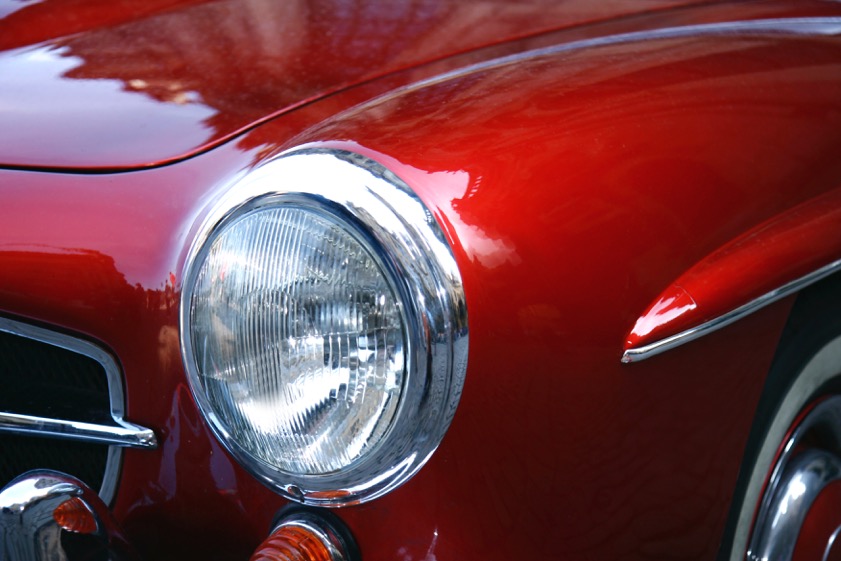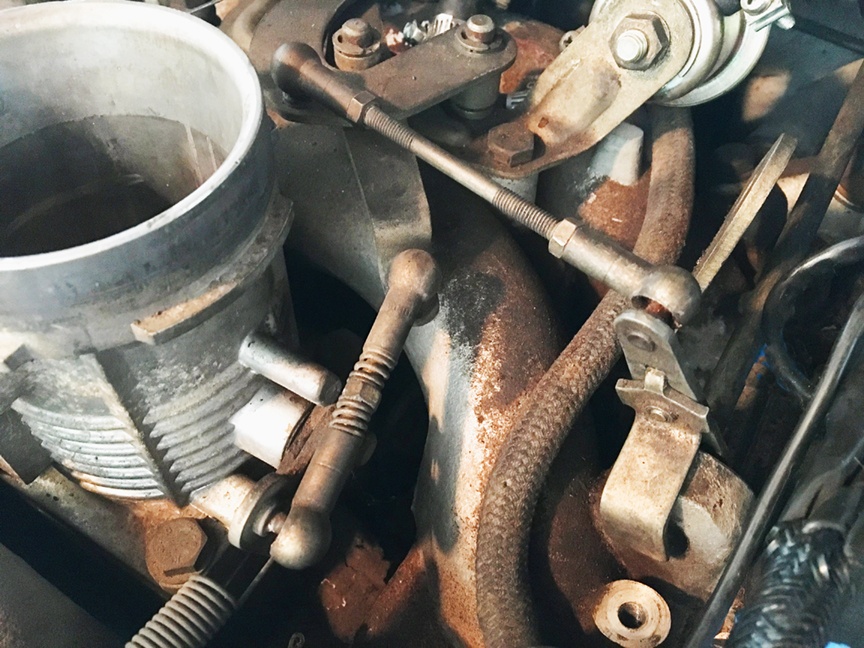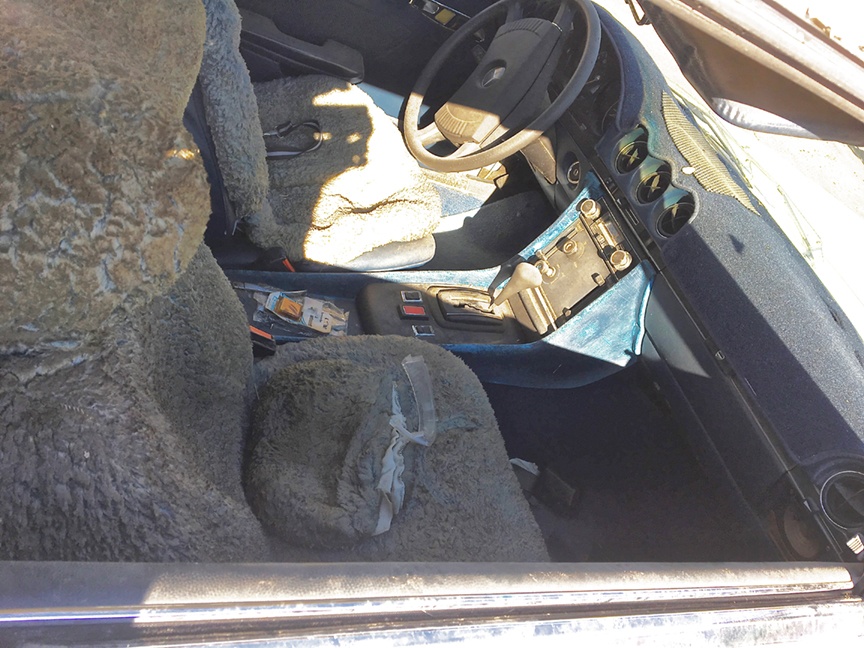
You’ve always dreamed of driving out of your garage on a beautiful day in something that turns heads at every stoplight. With horns honking and others giving a thumbs up, you simply grin, give a gentle wave and nod your head in acceptance. Your ego purrs in restrained dignity as a crowd gathers while
you fuel up. Slightly embarrassed, only slightly though, you proudly answers questions, as your fellow man drools in awe at your prized possession.

Perhaps you are looking for that fun classic to sink your teeth into, but just can’t find the right one for you. Or perhaps you are just too uneasy to deal with the unexpected of what comes with a decades old car. Fear not, if you are in a financial position to purchase a classic and have set a general restoration budget, you are more than likely in a good position to begin your journey of classic car ownership.
Our journey begins with a 1975 Mercedes-Benz 450SL that was abandoned in the desert behind someones home in 2009. Rumor also has it, that four years later, it was re-abandoned again at a private parking lot in downtown Phoenix, Arizona, only to sit for yet another three years.
Why I purchased this car is still somewhat of a mystery to me. I certainly did not have plans to acquire another classic, let alone one that needed a full restoration. As the photos clearly show, it had indeed suffered a fair bit, sitting uncovered in the desert elements for seven years. While the Desert Southwest receives very little rain to introduce rust, the nearly 345 days of sunshine and summertime temperatures that can reach 120oF (48°C), is a killer for any plastic and rubber components. From bleaching to cracking, the UV light and intense heat quickly destroys and often beyond repair.
Despite the extreme neglect, this 450SL endured, several great discoveries were made during the initial inspection. While the underside was densely laced with cobwebs and the interior draped in layers of dust from years of sand storms, and the passenger side window being down, the chassis (unibody) and paneling were completely rust free. Every original part was on the car. Even broken parts were scattered about the interior. Original manuals, tool kit, jack, convertible and hard top handle locks. were in one location or another. The car had obviously been loved at one point to to still have all the pieces.
Feeling quite good about the find so far, preparing to open the hood created a deep sinking feeling of what might or might not be there and caused a great deal of angst. At this point, emotion was driving the day on the potential purchase, but there was still much to be explored before any responsible decisions could be made to acquire this car. With the hood up, it was truly relieving to see it actually had an engine and one that
appeared to be beautifully intact, other than being layered in more desert dust. The engine also appeared to be leak free after all the years sitting and no drips on the ground below! But, was it a winner? Was it worth it? Just how much was one going to have to sink into this project.

So what made this particular car worth the purchase price along with an extensive restoration? In part, the owner wanted to get rid of the car and threw out a sale price of $500. Fantastic price, right. Maybe, maybe not. While this might seem to be a no brainer at first glance, as my friend told me, “you’d be an idiot not to buy that”, there are still many things to keep in mind. It truly does look like the find of a lifetime and in this particular case it was, however, the real cost of getting this car back to it’s full glory, the way most of us would want to drive or show off the car, carries a fairly steep price tag of roughly $16,000- $20,000. It should also be noted that a considerable amount of additional expense will not be incurred due to the fact that most of the work will be done in my garage, by me. Sending this car out for all work to be done by various shops, would add roughly $15,000, bringing the total to an estimated $35,000 to $40,000 at completion.
Budgeting is key! Too often cars come home with an owner who has very high hopes, only to have the car re-stored in their backyard and this time at a financial loss. It is also important to know your mechanical abilities before you make the commitment and know that you can fairly easily acquire all the necessary parts at reasonable prices. What you can’t foresee going wrong will go wrong and parts you expected to be ok, won’t be. Tools will also need to be figured into the equation and some specialty tools carry a hefty price tag. In as much, don’t skimp on the right tools. Using inferior tools or the wrong tools to avoid spending money, will most likely cost you more of everything in the end!
Finally, do thorough research on resale and auction values of the particular car model. A considerable factor in deciding to purchase this 450SL, was knowing the purchase price, plus the general cost of restoration could be recovered. Unless you just can’t be without a particular car and money is no object, remaining within the
limits of recouping the purchase and restoration costs with a good potential of a few thousand dollar profit, is always a great idea to determine prior to purchase.

LIFE LESSON: Don’t be scared off by old cars that need work. Do your homework and examine all possibilities. Know your skill set and the amount of work you will be able to do yourself. Include the price of tools (general and specialty) shop products (cleaners, rags, fluids, etc.) hardware, for the numerous, rotten, stripped, beheaded bolts, washers and of course the many rubber, plastic, body, interior, vacuum, chrome, lenses, lights, mechanical parts, tires... that will need attention or replacement. And don’t forget, classic car insurance.
Keep a detailed spreadsheet of every item, cost, and date installed on the car and the date the work was performed. Take photos, lots of photos along the way of everything you do, before and after. Don’t forget, added value also lies in the proof and integrity of your work or your shops work. Even if the car is being worked on by a shop, stop by regularly and take photos. Most shops have no problem with this and welcome your interest in the project. Classics are fun and bring joy not only to you and your family, but to everyone who sees one going down the road.
Before you buy, consider this
- Cost of Car
- Cost of Restoration
- Value of Car after Purchase and Restoration
Individual costs to look at
This is a generic list and not all cars are equipped with the following components or options.*
- Classic Car Insurance (restoration or full)
- Basic Tools
- Specialty Tools (model specific)
- Hoses (cooling, power steering, oil cooler, transmission cooler, A/C, window washer, heater, fuel, vacuum)
- Belts
- Tires
- Rubber Suspension Parts
- Shocks
- Suspension Springs
- Engine Mounts
- Sub-Frame or Body Mounts
- Timing Chain
- All Engine Seals (valve cover, head gasket, crankshaft, transmission, oil pan)
- Water Pump
- Power Steering Pump
- A/C Compressor (does it cool well at idle)
- Alternator (charging at capacity)
- Emissions System Components (catalytic converter, air pump, lines, check valves)
- Brake Booster Unit (hard to operate)
- Brake Reservoir
- Brake Master Cylinder (spongey peddle)
- All Disc Brake Components or Drum Type
- Radiator (clean or replace)
- Wipers (washer and motors)
- Lights and Lenses (bulbs, cracks in lenses, not functioning)
- Wiring (all)
- Carpeting (worn, stained)
- Upholstery (torn, faded, stained)
- Convertible Top (cracked, stuck)
- Seat, Back and Headrest Cushions
- Gauges (do they work, warning lights)
- Heater Core and A/C (leaking)
- Sound Damping Mats (optional)
- Missing Parts/Accessories (trim, bezels)
- Glass (Cracked windshield)
- Rear Window Defroster (not heating)
- Weather Stripping
- Locks/Actuators (power locks)
- Ignition Switch (not activating starter or not returning)
- Starter Motor
- Fuel Tank (Rusting or full of old fuel)
- Fuel Sender Unit (improper read)
- Battery
- Power Windows (smooth operation)
- Switches (power window, power locks, turn signal, heater/a/c, power seats, antenna, radio, cruise control, hazard, headlights, wiper/washer, rear window defroster, door/trunk, glovebox light)
- Fuel Injection or Carburetor (injectors, wiring harness, seals, gaskets)
- Fuel Pump
- Pressure Regulator
- Thermostat
- Cooling Fan Clutch
- Heat & A/C Blower Motor
- Transmission (fluid level and color)
- Bearings (wheel/engine)
- Badges and Emblems
- Trim Molding (interior exterior)
- Chrome Trim
- Bumpers and Bumper Guards
- Exhaust System (catalytic converter, resonator, muffler, hangers, gaskets...)
- Manifold Gaskets (intake and exhaust)
- Spark Plugs and Wires
- Distributor (cap, rotor, electronic ignition)
- Vacuum Advance (may disconnect with electronic ignition)
- Cruise Control (holding and adjusting speed)
- Filters (air, transmission, power steering, fuel, oil)
- Dashboard (check for cracks)
- Oil Pressure (at operating specs.)
- Camshaft(s)
- Oil Pump
- Oil Cooler
- Transmission Oil Cooler
- Sensors (coolant, air, fuel, fan, A/C)
- Seat Belts & Air Bags (buckles, latches, straps winders)
- Crank Windows
- Oxygen Sensors
- Coolant Overflow Tank
- Wheels or Hubcaps
- Door Alignment (hood, trunk, doors)
*This list is ONLY a general guide of what to look for when deciding on whether or not to purchase a classic. Always check everything thoroughly and drive it when at all possible. If it doesn’t look right or sound right, it probably isn’t. Never rush into a purchase!











